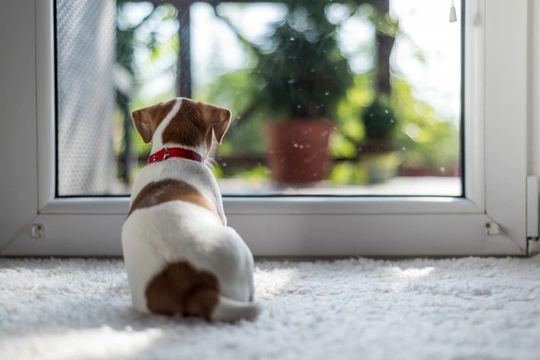
How to handle and manage your puppy when you come home after leaving them alone
Knowing that you have a dog waiting for you at home can be very gratifying for all dog owners, who know that whatever the day throws at them, there will be a welcoming, friendly face and a lot of love waiting for them when they get back through the door. When you first get a new puppy, the pup is likely to be all that you think about for quite some time – particularly any time you have to leave them on their own, or when you start getting them used to keeping their own company for a few hours at a time when you are at work.
It is understandable to be keen to get home and delighted to see your puppy, and want to make a big fuss of them after even a short absence – but this is something you should manage carefully, to avoid inadvertently teaching your puppy bad habits.
It might well seem totally natural that as soon as you get home you hug your puppy, pay them lots of attention immediately and allow them to jump and climb all over you for a cuddle, because you missed each other – but this can in turn lead to problems later on.
In this article, we will look at how to handle and manage your puppy or juvenile dog when you come back home after work, or any other time you have left your pup alone for a reasonable but not excessive amount of time. Read on to learn more.
Manners at the door
First things first, your puppy or dog of any age is likely to greet you at the door or coming running to the door when you open it – or if they are confined to a crate or closed off from the main access door, as close as they can get!
However, your puppy should never try to dart or push out through the open door, or tackle you in the doorway – teach your puppy from a young age that whether or not the front door is open, they do not go outside without permission. This is important both to protect your pup from running out onto the road or into a hazard, and also, to teach them the basic manners and responses that will set the parameters of good behaviour and appropriate reactions later in life.
Greetings
When you do first walk in and are putting your bags down or taking off your coat, it is fine to say hello to your pup and pat them, but don’t get them over excited at this stage or allow bad behaviour like jumping up to go unchecked. Try to keep your pup calm at this point, letting them know that you are pleased to see them, but without making a big fuss.
Taking care of the essentials first
When you have got inside and said hello, the first thing you should do is take your puppy outside to do their business. This is a good idea regardless of how long your pup has been alone for, and will help to teach them to toilet when they get the chance.
It can also help to avoid little accidents that occur when your pup needs to pee and is also excited to see you, which makes for a very bad combination!
Quality time
When your pup has had the chance to pop outside to the loo and get over their first wave of excitement at your return, you can think about giving your pup your full attention and spending quality time with them, having a cuddle, allowing them to sit with you or starting a game – or taking them out for a walk or something else they enjoy.
Pups are generally highly excitable and don’t take much to get going – and your pub being excited that you are home and letting you know this is fine, and not something you should try to curb. However, it is of course still important to ensure that your puppy obeys the rules, minds their manners and doesn’t get carried away, jumping up or nipping at you in excitement.
Problems to avoid
Jumping up is the main bad behaviour that you will probably face during your first few weeks and months with your new puppy, and particularly when you return home and your pup is very excited. You should take care to start telling your pup to get down and curb jumping up from the get-go, because this behaviour becomes established very quickly, and is hard to correct later on when your dog is an adult.
However pleased you are to see your pup – and you may well be just as excitable as they are – it is important to set and stick to rules, and not allow your pup to get away with some things some of the time, but not others.
It can take a while for a good greetings routine to become established with a new pup, and you will need to be patient and consistent – but a little work during your pup’s first year will make the rest of your life together much easier!



